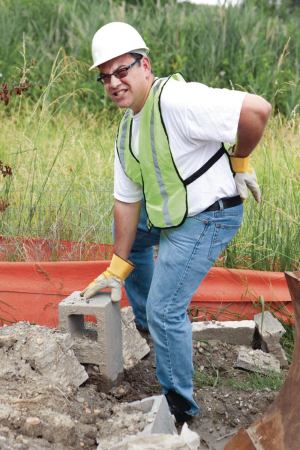Reducing construction injuries by reducing manual lifting
 In the construction industry, manual lifting and moving heavy materials are the leading causes of disabling injuries. Strains, sprains and related soft tissues injuries affect a majority of construction workers and cost billions of dollars to businesses. Back injuries are the most common disabling injuries for construction workers and approximately 3 out of 4 back injuries that require time off to recover are due to over exertion. Other common disabling injuries suffered by construction workers are hand and wrist injuries as well as shoulder injuries. Many of these injuries can be prevented by reducing manual material handling.
In the construction industry, manual lifting and moving heavy materials are the leading causes of disabling injuries. Strains, sprains and related soft tissues injuries affect a majority of construction workers and cost billions of dollars to businesses. Back injuries are the most common disabling injuries for construction workers and approximately 3 out of 4 back injuries that require time off to recover are due to over exertion. Other common disabling injuries suffered by construction workers are hand and wrist injuries as well as shoulder injuries. Many of these injuries can be prevented by reducing manual material handling.
PLANNING AND COMMUNICATION ARE KEY TO PREVENT INJURIES
The Center for Construction Research and Training (CPWR) is working on creating a new program for contractors to help them with practical tools and information to plan for safe manual materials handling while staying productive and profitable. The CPWR works with contractors to define the best way to store and move heavy material on construction sites. So far they found that careful planning and communication were key factors in protecting workers from manual lifting injuries.
Planning starts at bidding. Knowing what type of material will be used in which quantity will help in determining the total weight of the material and planning how and where it will be stored and what type of equipment will be required to move it.
After the bid is won its time to plan in detail how material will be delivered, stored and used on the construction site in an optimal manner, avoiding downtime, material damages and injuries related to manual handling. The project manager or the general contractor, the suppliers as well as the workers should all be involved in the discussion and decisions should be clearly communicated to all of them. It is important to determine who will be in charge of coordinating when and where the material will be delivered and stored as well as to make sure that the supervisory personnel is proprely trained on how to use lifting equipment. Who will train the workers and how to keep track of the material handling and assignments are other questions that need to be answered at this time.
When the project starts, daily planning and communication with workers is essential. Reviewing material delivery, handling tasks, location and availability of equipment and responsibilities of each team member on a daily basis will help keep everyone focused on safety and productivity
At the end of a project looking back on what could have been improved will help improve for the next one.
If you want to know more about this new program, the CPWR is having a free webinar this afternoon at 2pm.
 New York Personal Injury Attorneys Blog
New York Personal Injury Attorneys Blog


